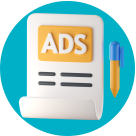Selecting Appropriate Advertising Platforms
Based On Your Goals
Defining clear campaign objectives and selecting the right advertising platforms as a scientific illustrator is like charting a course for success in the vast ocean of digital marketing. It's like having a compass that guides you towards achieving your dreams.

When you know exactly what you want to achieve, whether it is increasing brand awareness, driving traffic to your portfolio, generating leads, boosting engagement, or increasing sales, you can tailor your marketing efforts precisely to reach those goals.
Selecting the appropriate advertising platforms is equally vital - it's like choosing the perfect ship to sail on.
You want to be where your target audience is, engaging them on social media, capturing relevant leads through search ads, or networking with professionals on LinkedIn.
By aligning your goals with the right platforms, you can make waves in the digital world, gaining visibility, attracting clients, and propelling your scientific illustrations to new heights. So, set your sails with clear objectives and navigate the advertising waters with the right platforms to steer your artistic journey towards success.
Step 1: Defining Campaign Objectives
Before you embark on your digital marketing campaign, it's crucial to outline clear and specific objectives. Ask yourself, "What do I want to achieve?" Your objectives will serve as the guiding light throughout the entire campaign, helping you stay focused and measure success. Here are some objectives you might consider:
1. Increase Brand Awareness:
If you're just starting or looking to expand your reach, this objective is perfect for getting your name out there and making people aware of your incredible scientific illustrations.
2. Drive Traffic to Portfolio:
If your goal is to showcase your work to a broader audience, focus on driving traffic to your online portfolio or website.
3. Generate Leads:
If you offer specific services, like custom illustrations or scientific animations, you might want to focus on capturing leads from potential clients.
4. Boost Social Media Engagement:
For those who wish to grow their social media presence, this objective focuses on increasing likes, shares, comments, and followers.
5. Increase Sales/Commissions:
If you have products or services available for purchase, your objective might be to drive sales and commissions.

Remember, you can have multiple objectives, but it's essential to prioritize them and ensure they align with your overall business goals.
Step 2: Choosing the Right Advertising Platforms
Now that you've defined your objectives, it's time to choose the most suitable advertising platforms to achieve them. The advertising landscape is vast, but as a scientific illustrator, you'll want to focus on platforms that resonate with your target audience and align with your budget. Here are some platforms to consider:
Social Media Platforms:
These are excellent for increasing brand awareness, engaging with your audience, and driving traffic to your portfolio. Instagram, Twitter, and Pinterest are particularly popular among artists and can be great places to showcase your work.
Google Ads:
If you want to target people actively searching for scientific illustrations or related terms, Google Ads (including Search and Display Ads) can help you capture relevant leads.
LinkedIn:
If your illustrations cater to a more professional audience, LinkedIn can be a valuable platform for networking and promoting your work to scientists, researchers, and other professionals in the field.
Art & Design Communities:
Websites like Behance and Dribbble are specifically designed for artists to showcase their portfolios and connect with potential clients or collaborators.
Email Marketing:
Email newsletters can be an effective way to nurture leads, engage with your audience, and promote your latest illustrations, blog posts, or updates.

Content Marketing & Blogging:
Creating valuable content related to scientific illustration can attract organic traffic to your website and establish you as an authority in your niche.
Conclusion
As you select platforms, keep your target audience in mind. Research where they spend their time online and which platforms align with your campaign objectives. Always track your results, analyze the data, and make adjustments as needed to optimize your efforts.
Remember, digital marketing is all about experimentation and continuous learning. Be patient, stay consistent, and let your passion for scientific illustration shine through your marketing efforts.
Conducting Keyword Research And Audience Targeting To Refine Your Ad Targeting
Keywords are like magical words that connect your business with the right people in the vast ocean of the internet. In simple terms, a keyword is a word or a phrase that users type into search engines when they're looking for something specific.
When you incorporate relevant keywords into your website content, social media posts, or online ads, you're telling search engines, "Hey, my illustrations are a perfect match for what people are searching for!" This magical connection is what makes keywords so essential in the digital world. They boost your visibility, attract the right audience, and set you on the path to success as a scientific illustrator.

The process of keyword research and audience targeting to refine your ad targeting as a scientific illustrator is all about discovering the best paths to reach your potential clients and audience. Here's a step-by-step guide to help you define your main keywords:
Understand Your Niche and Audience
As we've seen throughout this course, getting to know your target market is the first and most crucial step. So, I bet you already have a clear and written-down understanding of your niche by now.
Remember, consider the specific subjects, industries, or areas of science your illustrations cater to. Next, identify your target audience niche - scientists, researchers, educators, or any other groups interested in scientific visuals. Understanding your niche and audience will be the foundation for your keyword research and targeting efforts.
Brainstorm Relevant Keywords
Now, let's dive into the world of keywords! Put on your creativity hat and brainstorm a list of relevant keywords and phrases that relate to your scientific illustrations. Think about the scientific terms, specific subjects, or even broader topics that your target audience might use when searching for illustrations or related content online.
Use Keyword Research Tools
To expand and refine your list of keywords, make use of keyword research tools. Tools like Google's Keyword Planner, Ubersuggest, or SEMrush can be incredibly valuable in identifying high-traffic keywords, related terms, and even the search volume for each keyword. These tools will help you discover popular search queries that align with your niche and audience.
Long-tail Keywords and Phrases
Don't forget about long-tail keywords and phrases! These are more specific and less competitive than broader terms. They can be incredibly valuable for reaching a highly targeted audience. For example, instead of targeting "scientific illustrations," you could use "botanical illustrations for research papers" or "medical illustrations for educational content."

Incorporate Keywords into Your Ads and Content
Once you have a refined list of relevant keywords, incorporate them into your ad copy, headlines, and content on your website or landing pages. This will help your ads appear in front of the right audience when they search for related terms.
Test and Monitor Your Campaign
Finally, it's time to set sail! Launch your ad campaigns with the targeted keywords and audience segments you've identified. Keep a close eye on the performance of your ads and adjust as needed. Use the data from your ad platform's analytics to fine-tune your targeting, bidding, and messaging for optimal results.
Conclusion
Remember, keyword research and audience targeting are ongoing processes. Stay curious, keep experimenting, and adjust your strategies as you gather more insights. This voyage will lead you to connect with the right audience and navigate towards success as a scientific illustrator! Happy exploring!
How to Use Google's Keyword Planner, Step by Step
Hey there! When it comes to finding keywords, there are plenty of tools out there. But you know what? I'd recommend starting with Google's Keyword Planner because it's not only free but also one of the most powerful tools to discover effective SEO keywords. So, here's a step-by-step guide to get you started:
Step 1: Access Google Ads
To embark on this exciting keyword adventure, head over to Google Ads (don't worry, it's free to use!). If you don't have an account yet, you can easily sign up and get ready to explore the magic of Keyword Planner.
Step 2: Navigate to Keyword Planner
Once you're in Google Ads, look for the "Tools & Settings" icon in the top right corner (it looks like a wrench). Click on it and select "Keyword Planner" from the dropdown menu. Voilà! You're now at the gateway to a treasure trove of keywords.

Step 3: Find New Keywords
Here's where the fun begins! Click on "Discover new keywords" to start your search. Type in words or phrases that are relevant to your scientific illustrations. Think about what your potential clients might be searching for - scientific terms, subjects, or specific interests related to your artwork.
Step 4: Refine Your Search
After clicking "Discover," Google will present you with a goldmine of keyword ideas. Take a look and sort through the list. You can filter by location, language, and even include or exclude specific terms. This helps you discover keywords that are most relevant to your target audience.
Step 5: Analyze Keyword Ideas
As you sift through the keyword ideas, pay attention to their search volume and competition level. High search volume means more people are searching for that term, but it may also be more competitive. Consider a mix of popular and less competitive keywords to find the sweet spot.

Step 6: Evaluate Keyword Relevance and Competition
As you gather your list of keywords, evaluate their relevance to your scientific illustrations and how well they match your campaign objectives. Look for keywords that have a balance between search volume and competition. Highly competitive keywords might be challenging to rank for, especially if you're just starting. Consider a mix of both broader and more specific keywords to target different segments of your audience.
Step 7: Get Historical Metrics
Wondering how certain keywords have performed in the past? Click on "Get search volume and forecasts" to access historical data. This will give you insights into the trends and popularity of specific keywords over time.
Step 8: Save and Group Your Keywords
Google's Keyword Planner lets you save the list of keywords it displayed into an Excel or Google Sheets file. Organize your keywords into relevant groups or themes, keeping them organized in the files related to each campaign.
This grouping will help you later when creating focused ad groups for your campaigns. Keep things organized and set sail with a well-structured keyword strategy. Check out the image below - I've circled in yellow where you can find the button to download the list.
Step 9: Plan Your Budget
Remember, the keyword sea may be vast, but you have control over your budget. Plan wisely, set your bids, and allocate your resources where they'll make the most impact.
Step 10: Put Your Keywords to Work
Now that you've discovered your treasure trove of keywords, it's time to put them into action! Use these keywords in your website content, blog posts, and of course, your Google Ads campaigns. They'll help you navigate the vast online ocean, attracting the right audience to your extraordinary scientific illustrations.

So, there you have it! With Google's Keyword Planner by your side, you're well-equipped to chart a course to keyword success.
Creating Compelling Ad Copy And Visuals That Resonate With Your Target Audience
Let's dive into the thrilling world of crafting compelling ad copy and visuals that truly speak to your audience. Imagine it like painting a masterpiece that captivates hearts and minds! Here's why it's so crucial:

Connecting Emotionally
Hey, we're all human, right? Your ad copy and visuals are your virtual handshake with your audience. When you create content that resonates, it's like giving them a warm hug. If you're targeting scientists or educators, use language and visuals that ignite their passion for learning. Appeal to their curiosity, and watch them gravitate towards your scientific illustrations like bees to honey!
Standing Out in the Crowd
Picture this: a bustling marketplace of ideas. Among the hustle, your ad needs to be the one that makes people stop and say, "Whoa, this is cool!" Crafting compelling ad copy and visuals helps your artwork shine like a beacon in the night. Dare to be different, inject creativity, and let your personality shine through. Your uniqueness is what sets you apart from the rest.
Solving Problems
People love a solution to their problems, and your ad copy can be that magical solution! Address the pain points of your target audience. Do scientists struggle to explain complex concepts? Your illustrations can make it crystal clear. Does your art make learning engaging for students? Showcase it! By highlighting how you meet their needs, you're creating a win-win situation.
Building Trust
Trust is the glue that binds relationships, even in the digital realm. When your ad copy and visuals reflect authenticity and professionalism, you're building a foundation of trust. Share your expertise, show off testimonials if you have them, and be transparent about what you offer. This trust can turn casual browsers into loyal clients who keep coming back for more of your breathtaking illustrations.
Call to Action Magic
Every good story needs an exciting ending, and your ad is no different! A compelling call to action (CTA) is like the "To be continued…" at the end of an episode. It prompts your audience to take action, whether it's clicking, exploring, or purchasing. Be clear, concise, and enthusiastic in your CTA – invite them to be a part of your journey!
Embracing Visual Storytelling
A picture is worth a thousand words, and your visuals are the heart of your storytelling. Use imagery that tells a story, elicits emotions, and leaves a lasting impression. Whether it's an eye-catching infographic explaining a complex process or a heartwarming illustration that sparks nostalgia, let your visuals weave tales that your audience won't forget.

So, there you have it! Creating compelling ad copy and visuals isn't just about selling – it's about forging meaningful connections, inspiring action, and leaving a mark on the hearts of your audience.
